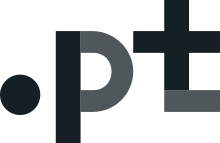 | |
| Introduced | 30 June 1988 |
|---|---|
| TLD type | Country code top-level domain |
| Status | Active |
| Registry | Associação DNS.PT |
| Sponsor | Associação DNS.PT |
| Intended use | Entities connected with Portugal |
| Actual use | Very popular in Portugal |
| Registered domains | 1,818,537 (March 2024)[1] |
| Registration restrictions | Various restrictions for different subdomains; .com.pt is unlimited |
| Structure | Registrations are taken directly at second level or at third level beneath some second-level labels |
| DNSSEC | yes |
| Registry website | pt.pt |
.pt is the Internet country code top-level domain (ccTLD) for Portugal and is managed by Associação DNS.PT. It has the following second-level domains:
- .com.pt: no restrictions; online registration
- .edu.pt: education
- .gov.pt: Government of Portugal
- .int.pt: international organizations or diplomatic missions in Portugal
- .net.pt: telecommunications providers
- .nome.pt: individuals (nome is Portuguese for name)
- .org.pt: Non-profit organizations
- .publ.pt: publications (e.g. newspapers)
As from the 1 May 2012 Registration directly at second-level is available, without restrictions.[2] On the first week there was a 28984 new domains register under the .pt
Since July 1, 2005, some characters with diacritics have been supported in domain names (IDN). Currently permitted characters: à, á, â, ã, ç, é, ê, í, ó, ô, õ, ú, ü. These are the only accentuated characters used in Portuguese words.
Apart from .gov.pt, Portuguese subdomains were slow to catch on, because many people had already registered under .pt when the new ones became available. Many companies, colleges and people still prefer to use a .pt because these are harder to get and simpler to remember. However, the .com.pt subdomain is being heavily promoted by the registry, and now has numerous registrations and active Web sites. Others such as .nome.pt for individuals are still uncommon.
In the early years, FCCN (Fundação para a Computação Científica Nacional) tried to keep control of the .pt domain using stringent rules, which were adjusted a number of times. The precedent set by domains which were already registered but which would not be able to be registered under updated rules led to lawyers requesting the registry of any domain based on the principle of equal treatment.[citation needed] When the situation was out of control, FCCN tried to promote subdomains like com.pt. Nevertheless, since the registration directly under .pt was still available, users tended to prefer these.
It is estimated that the .pt suffix comprises a little less than 10% of all the Portuguese-language Internet.[3][original research?] It is the third most popular Portuguese-language suffix, after .br and .com, and ahead of .net, .org and .info, all above 10 million pages.[citation needed]
YouTube Encyclopedic
-
1/1Views:270 982
-
How To Finish Your Foam Fireplace (Pt. 2/2)
Transcription
References
- ^ PT. "Estatísticas - .PT". www.dns.pt (in Portuguese). Retrieved 2024-03-19.
- ^ http://www.dns.pt www.dns.pt
- ^ As of 3 August 2008, of the about 910 million pages google lists as being written in Portuguese (value obtained by adding this to this), the .pt domain comprehends more than 83 million pages, to which should be added 7 million more, which Google reports to be written in other languages (see the total of pt pages here).
External links
- IANA .pt whois information
- .PT domain registration website (in Portuguese)
- Fundação para a Computação Científica Nacional (.pt registry) (in Portuguese)
- List of accredited registrars (in Portuguese)
